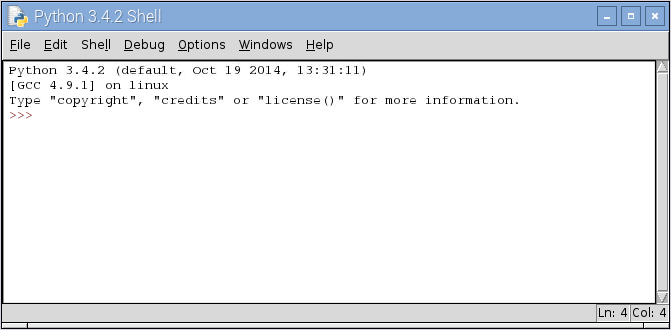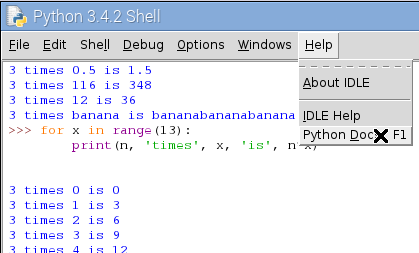The shell: awesome calculator
We can talk directly to Python through a program called “the shell”. You can run the shell by launching IDLE.
Launching IDLE
Launch IDLE from the “programming” section of the desktop menu. The menu will look a little like this:

Make sure you pick IDLE 3. This will open a “shell” window like this:

Python is ready to do things for you.
At the >>> prompt type 6*7.
The star * means multiplication.
Python will reply with the answer 42.
Hint
You will often make mistakes and get rude, red error messages from Python.
Don’t worry: this is normal in programming.
Try to guess what you did wrong and try again at the next >>> prompt.
Now try this:
>>> a = 7
>>> b = 6
>>> a * b
42
a and b are variables.
A variable is just a name you use for a value that matters to you.
The = means “make the name refer to this value”.
When we tell Python to do a calculation, instead of a number, we can use a variable that refers to the number. It could be an easy calculation, or one that’s a bit complicated:
>>> a + b
13
>>> (a+b) * (a-b)
13
You can make the variable (the name) mean something different any time you like. Try:
>>> a = 116
Let’s re-calculate the complicated expression, but without typing.
In the IDLE shell, you can re-use lines you typed earlier.
Put the cursor on the line that says (a+b) * (a-b),
using the mouse or the arrow keys,
and press enter.
This makes a copy of that line at the prompt, as if you had typed it.
Press enter again, and Python will work it out:
>>> (a+b) * (a-b)
13420
This time, the meaning of a is different,
so you get a different answer.
A variable can refer to any kind of information.
Sometimes you want to refer to a string of text.
Strings are written in quotes.
Single and double quotes mean the same,
and you can use + to stick strings together:
>>> h = 'Hello'
>>> w = "world!"
>>> h + ' ' + w
'Hello world!'
Again, again!
Just now, we used the same expression over again with a new value by copying. Often, you need to work something out for a whole list of values. Here is a list being assigned to a variable and printed out (try it):
>>> alist = [2, 0.5, a, 2*b, "banana"]
>>> print(alist)
[2, 0.5, 116, 12, 'banana']
Notice that the expressions in the list (like a and 2*b)
were calculated as the list was being made.
Now type at the prompt:
>>> n = 3
>>> for x in alist:
print(n, 'times', x, 'is', n*x)
After the first line, the IDLE shell will move the cursor across, so the next line starts in the right place. It will do that again after your print statement in case you have another line to enter. Enter an empty line and it will know you’ve finished.
If you made a mistake, use the trick you learned earlier to copy your first attempt to the prompt so you can edit it. Put the cursor at the end of the last line and press enter twice to try again.
What happened here?
Python looked at for x in and understood that you wanted to use
a variable called x, and make it refer to each of the values in the list.
And for each different value given to x,
you wanted to do what it says on the next line.
The print(...) part means print those things on a line in the shell window.
We call this whole thing a “for-loop”, because the computer goes round and round the same instructions, once for each value.
Often we want to do this with a list of numbers.
Remember you can save typing using the copy trick,
just change alist to range(13) and hit return on the last line:
>>> for x in range(13):
print(n, 'times', x, 'is', n*x)
If you did it right, Python will have replied with the 3-times table.
Or the times-table for whatever you set n to.
Try the biggest number you can think of.
The range(13) that comes where alist used to be,
means “all the numbers from zero up to, but not including, 13”.
You can see the lists range makes like this:
>>> list( range(10) )
[0, 1, 2, 3, 4, 5, 6, 7, 8, 9]
>>> list( range(5,13) )
[5, 6, 7, 8, 9, 10, 11, 12]
Space is big … mind-bogglingly big
Sometimes we need to multiply the same number together several times:
>>> 3*3*3*3
81
You could do that with a for-loop, but there’s a helpful shortcut for it:
>>> 3**4
81
>>> 3**5
243
>>> 3**6
729
Python will happily calculate enormous numbers. Eighty tens multiplied together is roughly the number of atoms in the Universe:
>>> 10**80
100000000000000000000000000000000000000000000000000000000000000000000000000000000
That’s still a small number to Python.
What’s a thousand twos multiplied together (2**1000)?
Or ten-thousand?
If you keep going like this, you will run out of computer memory or patience before Python gives up.
And my brain is so small
Programmers can’t possibly know everything about a language. (Python has thousands of features.) Don’t worry, help is at hand.
If your machine is connected to the Internet (or you have the documentation installed specially) the IDLE menu “Help” >> “Python Docs” will take you there in a browser.

If you’ve followed this project to here, you’re already up to Chapter 3 of the Tutorial.